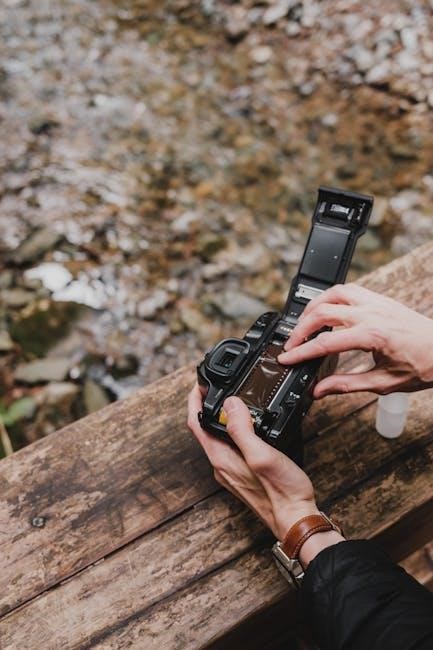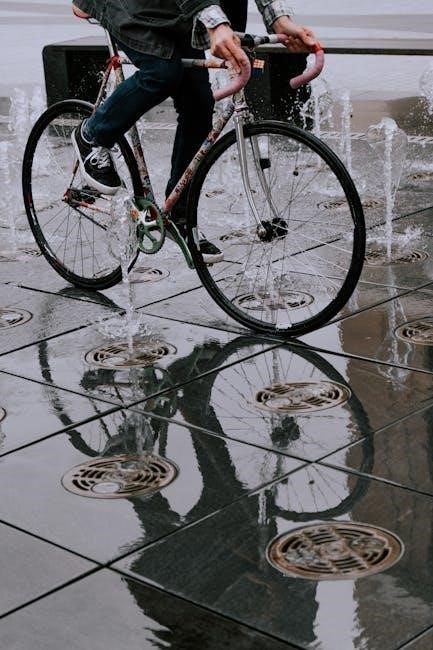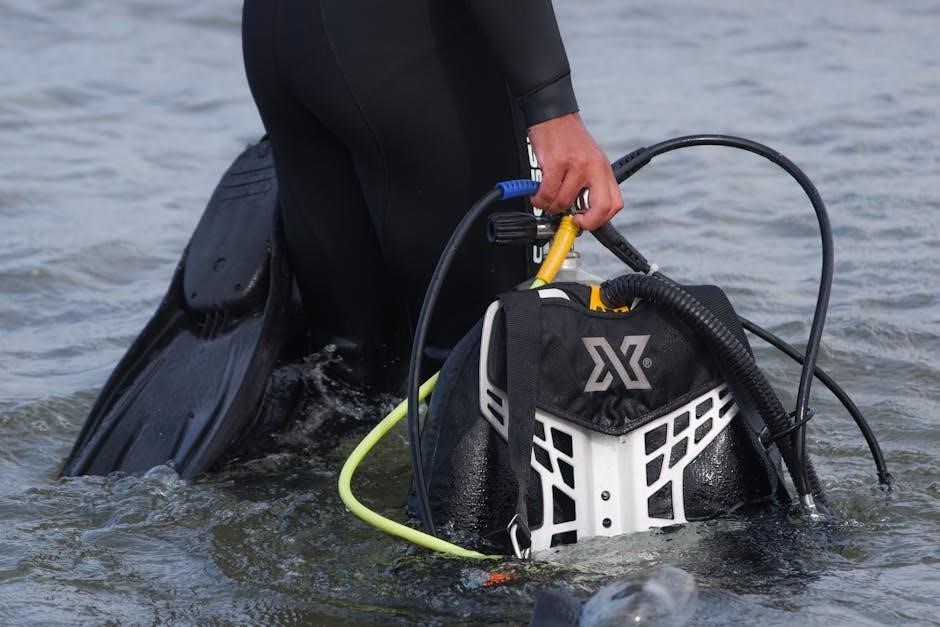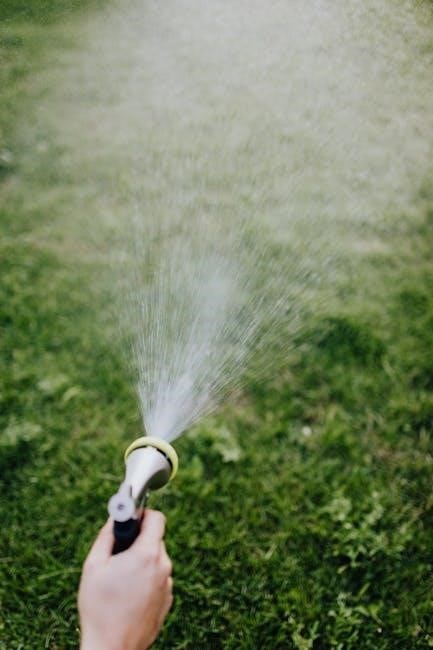The Clack Water Softener Manual PDF provides comprehensive guidance for installation, maintenance, and operation of your water softening system, ensuring optimal performance and longevity.
Overview of the Clack Water Softener System
The Clack Water Softener System is a high-efficiency solution designed to remove hardness minerals like calcium and magnesium from water, ensuring softer water for household use. It features a fully automatic control valve that manages the softening process, including regeneration and backwashing. The system is known for its durability and reliability, with a robust design that minimizes maintenance. Key components include the resin tank, control valve, brine tank, and distribution system. The control valve directs water flow during cycles, while the resin captures minerals, ensuring clean, treated water. This system is ideal for homes seeking to reduce scaling and improve water quality. The Clack WS1 series is particularly popular for its advanced features and user-friendly operation.
Importance of Using the Manual for Installation and Maintenance
Importance of Using the Manual for Installation and Maintenance
The Clack Water Softener Manual PDF is essential for ensuring proper installation, operation, and maintenance of your system. It provides detailed instructions to avoid common installation errors and guarantees the system functions as intended. Following the manual ensures compliance with safety standards and local plumbing codes. Regular maintenance tasks, such as resin replacement and control valve checks, are outlined to prolong the system’s lifespan. Troubleshooting sections help diagnose and resolve issues quickly. Additionally, the manual includes guidelines for electrical connections and water supply setup, ensuring a safe and efficient installation. By adhering to the manual, users can optimize performance, prevent damage, and maintain water quality. It serves as a vital resource for both professionals and DIY enthusiasts.

Components and Features of the Clack WS1 Series
The Clack WS1 Series includes a high-efficiency control valve, durable resin tank, and advanced bypass valve, ensuring reliable water softening with minimal maintenance and optimal water flow.
Key Parts of the Water Softener System
The Clack water softener system comprises essential components designed for efficient operation. The control valve directs water flow and manages regeneration cycles. The resin tank holds the exchange media, filtering minerals causing hardness. A bypass valve allows switching between treated and untreated water. The drain line facilitates discharge during regeneration, while the riser tube ensures proper water distribution. Proper installation and maintenance of these parts, as detailed in the manual, are crucial for optimal performance and longevity. Understanding each component’s role helps users troubleshoot and maintain their system effectively, ensuring consistent water quality.
Advanced Features of the Clack Control Valve
The Clack Control Valve is a sophisticated component designed to optimize water softening processes. It features fully automatic operation, managing regeneration and backwash cycles seamlessly. Constructed from durable glass-filled Noryl, it ensures long-lasting performance. The valve includes advanced flow control capabilities, allowing precise water distribution during treatment. Users can manually initiate regeneration, providing flexibility in system operation. It also offers adjustable cycle times and a built-in injector for efficient backwashing. These features enhance water treatment efficiency and adaptability to different water conditions. The control valve’s intelligent design simplifies maintenance and ensures consistent water quality, making it a central element of the Clack water softener system.

Installation Guidelines
Adhere to local plumbing codes, minimize drain-to-filter distance, avoid installing near water heaters without sufficient piping, and ensure proper connections for optimal system performance.
Pre-Installation Steps and Requirements
Before installing the Clack water softener, ensure you have all necessary tools and materials. Choose a suitable location with adequate drainage and access to water and power supplies. Prepare the site by ensuring the floor is level and stable. Review local plumbing codes to comply with regulations. Shut off the main water supply before starting work. Add gravel to the vessel to protect the bottom distribution system, followed by resin. Ensure the bypass valve is easily accessible for future maintenance. Position the drain line correctly, avoiding long distances to prevent backflow. Double-check all connections for tightness and proper alignment. Finally, verify that the electrical outlet meets the system’s requirements. Proper preparation ensures a smooth installation process and optimal system performance;
Plumbing and Electrical Connections
Connect the inlet and outlet hoses securely to the water softener, ensuring they are compatible with the system’s ports. Use Teflon tape on threaded connections to prevent leaks. Install a dedicated shut-off valve before the inlet to control water flow during maintenance. Place the drain line in a well-ventilated area, avoiding direct sunlight or freezing temperatures. Connect the drain line to the control valve, ensuring it slopes downward to prevent backflow. For electrical connections, plug the control valve into a nearby 120V outlet, avoiding extension cords. Ensure all plumbing adheres to local codes and that the system is grounded properly. Double-check all connections for tightness before powering on the system. Proper plumbing and electrical setup are crucial for safe and efficient operation of the Clack water softener.
Initial Setup and Configuration
After installation, power on the Clack water softener and follow the control valve’s setup instructions. Program the valve by entering your water hardness level and preferred regeneration settings using the keypad. Set the time and date to ensure the system operates on the correct schedule. Check the flow rate and adjust if necessary to match your household’s water usage. Pour water softener salt into the brine tank, ensuring it’s filled to the recommended level. Avoid overfilling to prevent salt bridges. Perform a manual regeneration cycle to initialize the system and ensure proper function. Allow the system to complete the cycle before using the treated water. Regularly review and update settings as needed to maintain optimal performance and water quality. Proper initial configuration ensures efficient operation and extends the system’s lifespan. Always refer to the manual for specific programming instructions tailored to your model. This step is crucial for achieving the best results from your water softener. Ensure all settings align with your local water conditions and usage patterns for maximum efficiency. If unsure, consult the troubleshooting section or contact customer support for assistance. Initial setup is a one-time process that lays the foundation for years of reliable service. By following these steps, you can enjoy softened water with minimal effort. Make sure to test the water hardness after setup to confirm the system is working correctly. Adjustments may be needed based on the test results. Keep the manual handy for future reference and updates. Proper configuration ensures that your Clack water softener operates at peak performance, providing softened water consistently. This initial setup is a critical step in maintaining the quality and longevity of your system. By carefully following the instructions, you can ensure your water softener functions optimally for years to come. Initial setup and configuration are essential for maximizing the benefits of your Clack water softener. Take the time to complete this process thoroughly to enjoy the full advantages of softened water in your home.

Maintenance and Troubleshooting
Regular maintenance ensures optimal performance. Monitor salt levels, clean the brine tank, and check for leaks. Refer to the manual for troubleshooting common issues like low water pressure or regeneration problems. Resolve errors promptly to maintain efficiency and extend system lifespan.
Regular Maintenance Tasks
Regular maintenance is essential to ensure the Clack water softener operates efficiently. Check salt levels monthly and refill as needed to prevent bridging. Clean the brine tank every 3-6 months to remove dirt and debris. Inspect the resin bed and replace it if damaged or exhausted. Monitor water hardness levels periodically to confirm proper softening; Lubricate moving parts of the control valve annually. Also, check for leaks in plumbing connections and drain lines. Refer to the manual for specific maintenance schedules and procedures. Regular upkeep prevents issues like reduced water flow or regeneration problems, ensuring consistent soft water supply and extending system lifespan.
Troubleshooting Common Issues
Troubleshooting your Clack water softener involves identifying common problems like low water pressure, stuck valves, or improper regeneration. Check for blockages in the venturi or drain line if water flow is restricted. Ensure the control valve is functioning correctly and not stuck in a cycle. If the system fails to soften water, verify salt levels and ensure the brine tank is clean. Address error codes by consulting the manual for specific solutions. Regularly inspect for leaks and tighten connections if necessary. If issues persist, refer to the troubleshooting section of the Clack Water Softener Manual PDF for detailed guidance and step-by-step solutions to restore optimal performance.

Control Valve Specifications
The Clack control valve is made of durable glass-filled Noryl, designed to regulate water flow automatically for softening and filtration processes, ensuring efficient system operation.
Technical Details of the Control Valve
The Clack control valve is constructed from durable glass-filled Noryl, ensuring resistance to corrosion and longevity. It is designed to manage all water treatment cycles, including backwash and regeneration. The valve features an advanced injector system that regulates water flow precisely, optimizing the softening process. Its robust design allows it to handle various water pressures and flow rates efficiently. The control valve is fully automatic, simplifying operation for users. It also supports manual regeneration, giving users flexibility. These technical specifications ensure reliable performance and durability, making it a key component of the Clack water softener system.
Operation and Programming of the Valve
Programming the Clack control valve is straightforward, allowing users to customize settings such as regeneration cycles and water usage limits. The valve operates automatically, initiating regeneration based on water usage or preset schedules. Manual override options are available for immediate regeneration. The valve’s digital interface provides clear status updates and error notifications. During operation, it efficiently routes water through various treatment stages, ensuring optimal performance. The valve’s advanced flow control and backwash capabilities maintain system efficiency. Regular programming updates can be made to adapt to changing water conditions. Detailed instructions for programming and operation are included in the manual, ensuring users can manage their water softener effectively.

Water Softener Manual PDF Content
The Clack Water Softener Manual PDF includes detailed troubleshooting tips, installation guides, and maintenance advice to ensure optimal system performance and longevity.
Structure and Organization of the Manual
The Clack Water Softener Manual PDF is structured logically, starting with an introduction, followed by installation guidelines, maintenance tips, and troubleshooting sections. It includes detailed diagrams and step-by-step instructions for ease of understanding. The manual is divided into clear chapters, each focusing on specific aspects of the system, such as control valve specifications and operational procedures. Additional resources like supplementary guides and FAQs are also highlighted, ensuring users can access all necessary information quickly. The organized format makes it easy for both professionals and homeowners to navigate and find solutions to common issues. This clear structure ensures that users can efficiently utilize the manual for setup, maintenance, and repair of their water softener system.
Key Sections Every User Should Review
Essential sections in the Clack Water Softener Manual include the installation guidelines, operation instructions, and maintenance schedules. These sections provide critical information for proper setup and ongoing care. The troubleshooting guide is another vital part, offering solutions to common issues. Additionally, the control valve specifications and programming details are crucial for optimizing system performance. Users should also review the safety precautions and warranty information to ensure compliance and understand their coverage. By focusing on these key areas, users can maximize the efficiency and lifespan of their water softener, ensuring it operates effectively and reliably over time.

Additional Resources
Find supplementary guides and documentation on the official Clack website. Access troubleshooting tips, installation guides, and additional support materials to enhance your water softener experience.
Where to Find the Clack Water Softener Manual PDF
To access the Clack Water Softener Manual PDF, visit the official Clack Water Softener website or authorized distributors. You can also download it from trusted platforms like Scribd or ManualsLib. Additionally, search engines like Google can help you find the manual by using keywords such as “Clack WS1 series manual PDF” or “Clack Water Softener Manual PDF.” Ensure you download from reliable sources to avoid unauthorized versions. For further assistance, contact Clack customer support or check their official documentation section. Always verify the manual’s authenticity to ensure compatibility with your specific model.
Supplementary Guides and Documentation
Alongside the Clack Water Softener Manual PDF, users can access supplementary guides and documentation to enhance their understanding and maintenance of the system. These resources include technical specification sheets, troubleshooting guides, and best practices for optimal water softener performance. Additional materials, such as control valve manuals and installation guides, are available on the official Clack website or through authorized distributors. For advanced users, supplementary documentation like motorized alternating valve instructions and flow control setup guides can be found online. Ensure to refer to these resources for detailed insights into specific components and operations, helping you maintain your water softener efficiently and effectively over time;

Common FAQs

Frequently asked questions about the Clack Water Softener Manual PDF include topics like installation, maintenance, and troubleshooting, ensuring users can resolve issues and understand system operations effectively.

Frequently Asked Questions About Installation
Common questions about installing the Clack Water Softener include inquiries about pre-installation steps, plumbing requirements, and electrical connections. Users often ask about the importance of ensuring the drain line is short and avoiding untreated water bypass issues. Many wonder if they can use existing plumbing or if upgrades are necessary. Another frequent question is whether the system requires a dedicated electrical outlet. Additionally, some users inquire about the recommended distance between the water softener outlet and the water heater inlet. These questions highlight the need for careful planning and adherence to local plumbing codes for a successful installation.
Common Queries on Maintenance and Repair
Users often inquire about the frequency of resin replacement and the best type of salt to use for optimal performance. Many ask how to address issues like low water pressure or uneven salt usage. Others seek guidance on troubleshooting error codes or understanding when to initiate manual regeneration. Some wonder about the proper way to clean or replace filters and whether DIY repairs are feasible. Additionally, there are questions regarding the maintenance of the control valve and ensuring the system’s longevity. These queries emphasize the importance of regular upkeep and understanding the system’s operational needs to prevent common issues and ensure efficient water softening.
